Plot
After his aircraft company's groundbreaking work on jet engine technology in the Second World War, John Ridgefield, its wealthy owner, employs test pilot Tony Garthwaite, a successful wartime fighter pilot, to fly new jet-powered aircraft. Garthwaite is hired by Ridgefield after marrying Ridgefield's daughter, Susan. Tensions between father and daughter are accentuated by Garthwaite's dangerous job of test flying. In a noteworthy illustration of the new technology, Susan accompanies Garthwaite on a ferrying assignment of a two-seater de Havilland Vampire to Cairo, Egypt, returning later the same day as passengers on a de Havilland Comet.
Ridgefield's plan for his new jet fighter, "Prometheus", has placed the company in jeopardy. [Note 1] The problems faced by the new jet aircraft in exceeding the speed of sound, the so-called "sound barrier", are ever present. Trying to break the sound barrier, Garthwaite crashes and is killed.
Shocked at the death of her husband and at her father's apparently single-minded and heartless approach to the dangers his test pilots face, Susan walks out on her father and goes to live with friends Jess and Philip Peel, another company test pilot. Ridgefield later engages Peel to take on the challenge of piloting "Prometheus" at speeds approaching the speed of sound. In a crucial flight and at the critical moment, Peel performs a counterintuitive action (foreshadowed in the opening scene of the film) which enables him to maintain control of the aircraft and to break the sound barrier. Eventually accepting that her father did care about those who died in tests, Susan changes her plan of moving to London and takes her young son with her back to live with Sir John.
Production
The strong relationship to aviation history in The Sound Barrier has led to its being characterised as a "semi-documentary". [4] The film pays tribute to the British effort in the historic advance in aviation of the development and final perfecting of the jet engine by Frank Whittle and Power Jets Ltd and others following. [5] [6]
David Lean had begun to gather research based on media reports of jet aircraft approaching supersonic speeds, interviewing British aeronautic designers. He even managed to fly with test pilots as he produced a 300-page notebook that he turned over to dramatist Terence Rattigan. [7] The subsequent screenplay concentrated on the problems of flying at supersonic speeds and is also loosely based on the story of aircraft designer Geoffrey de Havilland and the loss of his son. Geoffrey de Havilland, Jr. was the de Havilland company test pilot who was killed on 27 September 1946 attempting to fly faster than the speed of sound in the DH 108. [8] [9]
Kenneth More tested for the role of Tony. He says the part was offered to David Niven, with whom More was making Appointment with Venus but Niven turned it down. The role went to Nigel Patrick, who was more strongly established than More. [10]
John Derry, another de Havilland test pilot, has been called "Britain's first supersonic pilot", because of a dive he made on 6 September 1948 in a DH 108. [11] Contrary to what is depicted in the film, the first aircraft to break the sound barrier was the rocket-powered Bell X-1 flown by Chuck Yeager of the United States Air Force in 1947. His feat was portrayed in the 1983 film The Right Stuff . As Yeager, who was present at the US premiere, described in his first biography, The Sound Barrier was entertaining, but not that realistic – and any pilot who attempted to break the sound barrier in the manner portrayed in the film (forcing the centre stick forward to pull out of a dive) would have been killed. [12] [Note 2] Because the 1947 Bell X-1 flight had not been widely publicised, many who saw The Sound Barrier thought it was a true story and that the first supersonic flight was made by a British pilot. [14] [15] [16]
Studio filming was completed at Shepperton Studios, but the flying sequences were filmed at Chilbolton Aerodrome, Nether Wallop, Hampshire, under the direction of Anthony Squire. A Vickers Valetta and Avro Lancaster bomber served as camera platforms for the aerial sequences. [Note 3] With the assistance of the British Aircraft Constructors Association, aircraft featured in The Sound Barrier were loaned by Vickers, de Havilland and other British aerospace companies. [18] Footage of early 1950s British jet technology used in the film includes scenes of the de Havilland Comet, the world's first jet passenger airliner, the Supermarine Attacker and the de Havilland Vampire. [19] A Supermarine 535 prototype for the later Swift (VV119) featured as the experimental Prometheus jet fighter. Not unlike its screen persona, the Swift was an aircraft design that underwent particularly difficult teething problems during development. [20] [Note 4]
Malcolm Arnold (later knighted) composed the music score, for this, the first of his three films for David Lean. [22] The others were Hobson's Choice (1954) and The Bridge on the River Kwai (1957). [23]

Brigadier General Charles Elwood Yeager was a United States Air Force officer, flying ace, and record-setting test pilot who in October 1947 became the first pilot in history confirmed to have exceeded the speed of sound in level flight.

The sound barrier or sonic barrier is the large increase in aerodynamic drag and other undesirable effects experienced by an aircraft or other object when it approaches the speed of sound. When aircraft first approached the speed of sound, these effects were seen as constituting a barrier, making faster speeds very difficult or impossible. The term sound barrier is still sometimes used today to refer to aircraft approaching supersonic flight in this high drag regime. Flying faster than sound produces a sonic boom.
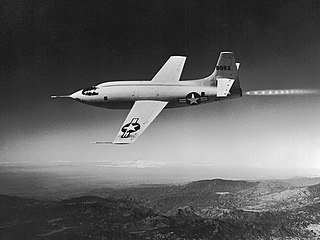
The Bell X-1 is a rocket engine–powered aircraft, designated originally as the XS-1, and was a joint National Advisory Committee for Aeronautics–U.S. Army Air Forces–U.S. Air Force supersonic research project built by Bell Aircraft. Conceived during 1944 and designed and built in 1945, it achieved a speed of nearly 1,000 miles per hour in 1948. A derivative of this same design, the Bell X-1A, having greater fuel capacity and hence longer rocket burning time, exceeded 1,600 miles per hour in 1954. The X-1 aircraft #46-062, nicknamed Glamorous Glennis and flown by Chuck Yeager, was the first piloted airplane to exceed the speed of sound in level flight and was the first of the X-planes, a series of American experimental rocket planes designed for testing new technologies.

The Miles M.52 was a turbojet-powered supersonic research aircraft project designed in the United Kingdom in the mid-1940s. In October 1943, Miles Aircraft was issued with a contract to produce the aircraft in accordance with Air Ministry Specification E.24/43. The programme was highly ambitious for its time, aiming to produce an aircraft capable of a speed of at least 1,000 miles per hour (1,600 km/h) during level flight, and involved a very high proportion of cutting-edge aerodynamic research and innovative design work.
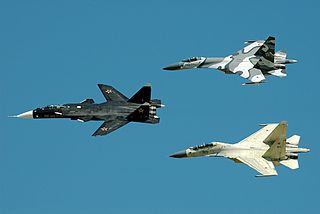
A swept wing is a wing angled either backward or occasionally forward from its root rather than perpendicular to the fuselage.

Hans Guido Mutke was a fighter pilot for the German Luftwaffe during World War II. He was born in Neisse, Upper Silesia.

A test pilot is an aircraft pilot with additional training to fly and evaluate experimental, newly produced and modified aircraft with specific maneuvers, known as flight test techniques.

The de Havilland DH.110 Sea Vixen is a British twin-engine, twin boom-tailed, two-seat, carrier-based fleet air-defence fighter flown by the Royal Navy's Fleet Air Arm from the 1950s to the early 1970s. The Sea Vixen was designed by the de Havilland Aircraft Company during the late 1940s at its Hatfield aircraft factory in Hertfordshire, developed from the company's earlier first generation jet fighters. It was later called the Hawker Siddeley Sea Vixen after de Havilland was absorbed by the Hawker Siddeley Corporation in 1960.

Robert Anderson Hoover was an American fighter pilot, test pilot, flight instructor, and record-setting air show aviator.

George Schwartz Welch was a World War II flying ace, a Medal of Honor nominee, and an experimental aircraft pilot after the war. Welch is best known for having been one of the few United States Army Air Corps fighter pilots able to get airborne to engage Japanese forces in the attack on Pearl Harbor and for his work as a test pilot. Welch resigned from the United States Army Air Forces as a major in 1944, and became a test pilot for North American Aviation.

The de Havilland DH 108 "Swallow" was a British experimental aircraft designed by John Carver Meadows Frost in October 1945. The DH 108 featured a tailless, swept wing with a single vertical stabilizer, similar to the layout of the wartime German Messerschmitt Me 163 Komet. Initially designed to evaluate swept wing handling characteristics at low and high subsonic speeds for the proposed early tailless design of the Comet airliner, three examples of the DH 108 were built to Air Ministry specifications E.18/45. With the adoption of a conventional tail for the Comet, the aircraft were used instead to investigate swept wing handling up to supersonic speeds. All three prototypes were lost in fatal crashes.

Geoffrey Raoul de Havilland Jr., OBE was a British test pilot. He was the son of Geoffrey de Havilland, the English aviation pioneer and aircraft designer.

John Carver Meadows Frost was a British aircraft designer. His primary contributions centred on pioneering supersonic British experimental aircraft and as the chief designer who shepherded Canada's first jet fighter project, the Avro Canada CF-100, to completion. He was also the major force behind the Avro Canada VTOL aircraft projects, particularly as the unheralded creator of the Avro Canada flying saucer projects.

Chalmers Hubert "Slick" Goodlin was the second test pilot of the Bell X-1 supersonic rocket plane, and the first to operate the craft in powered flight.
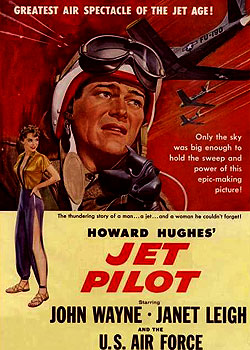
Jet Pilot is a 1957 American Cold War romance film directed by Josef von Sternberg and starring John Wayne and Janet Leigh. It was written and produced by Jules Furthman, and presented by Howard Hughes. Filming lasted more than eighteen months, beginning in 1949. The last day of shooting was in May 1953, but the Technicolor film was kept out of release by Hughes due to his tinkering until October 1957, by which time Hughes had sold RKO. Universal-International ended up distributing Jet Pilot.
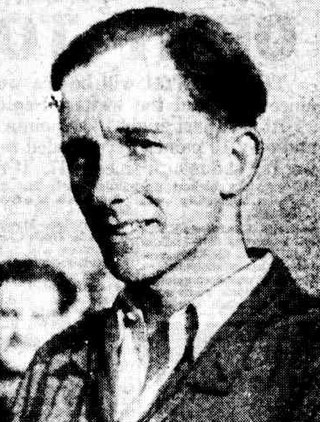
Squadron leader John Douglas Derry DFC was a British test pilot who is believed to be the first Briton to have exceeded the speed of sound in flight.
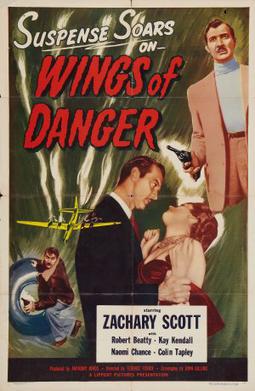
Wings of Danger is a 1952 British second feature crime film directed by Terence Fisher and starring Zachary Scott, Robert Beatty and Kay Kendall. The screenplay, based on the 1951 novel Dead on Course by Trevor Dudley Smith and Packham Webb, concerns a pilot who is suspected of smuggling. It was released in the United States under its working title of Dead on Course.

The Net is a 1953 British aviation thriller film made by Two Cities Films, directed by Anthony Asquith and starring James Donald, Phyllis Calvert, Robert Beatty and Herbert Lom. The film is set in the world of aviation research and was based on the 1952 novel of the same name by John Pudney.
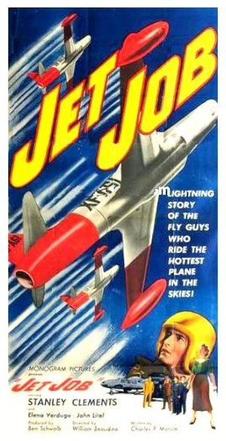
Jet Job is a 1952 American aviation action film directed by William Beaudine. The film stars Stanley Clements, John Litel and Bob Nichols. Jet Job features stock footage of various types of USAF military aircraft.

Herbert Henry Hoover was an American NACA experimental test pilot who, on March 10, 1948, became the first civilian and second person to break the sound barrier, a feat for which he was awarded the Air Medal "for meritorious achievement while participating in aerial flight." Hoover flew the iconic orange Bell X-1 during this historic flight. During his short career with NACA, Hoover completed more than a dozen supersonic flights.




















